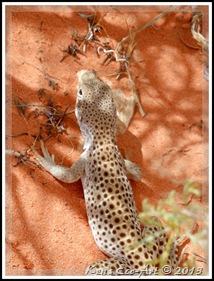Description: This is either a Long-nosed Leopard Lizard (Gambelia wislizenii), or a Large-spotted Leopard Lizard, a sub-species of the long-nosed leopard lizard. Both appear to be quite similar. The Long-nosed Leopard Lizard is a relatively large lizard ranging from 3¼ to 6 inches (snout-vent length). It has a large head, long nose, and a long round tail that can be longer than its body. They are endangered because of habitat destruction. The lizard has granular dorsal scales that can be white, cream, or gray with irregular brown or dark gray spots along its body and head. Sometimes they have dark bars across their back. The tail also has dark bars across it.  Juveniles have more highly contrasted markings compared to adults, often with rusty coloring on the back or bright red spots, and yellow on the thighs and under the tail. The male and female are different in appearance; the female being the larger of the two. Both sexes are capable of marked color changes. In its dark phase the lizard's spots are nearly hidden and light crossbars become quite obvious on both the body and the tail. In the light phase the opposite is true with the dominant color consisting of gray, pinkish, brown or yellowish brown hues. During the mating season females will develop reddish orange spots and bars on their sides and underneath the tail when gravid. Males develop pink or rusty wash on the throat, chest, and sometimes the body, during the breeding season. Juveniles have more highly contrasted markings compared to adults, often with rusty coloring on the back or bright red spots, and yellow on the thighs and under the tail. The male and female are different in appearance; the female being the larger of the two. Both sexes are capable of marked color changes. In its dark phase the lizard's spots are nearly hidden and light crossbars become quite obvious on both the body and the tail. In the light phase the opposite is true with the dominant color consisting of gray, pinkish, brown or yellowish brown hues. During the mating season females will develop reddish orange spots and bars on their sides and underneath the tail when gravid. Males develop pink or rusty wash on the throat, chest, and sometimes the body, during the breeding season.
They can generally be found in arid and semiarid plains growth, like bunch grass, alkali bush, sagebrush, creosote bush and other scattered low plants from sea level to around 6,000 feet, and prefer flat areas with open space for running, avoiding densely vegetated areas. The ground can be gravel, hardpan or sand. When in danger, it uses a defense mechanism known as "freeze" behavior, which means it runs underneath a bush, flattens its body against the ground and is motionless until the threat is gone, which is exactly what the one in these pictures appeared to do. Its speed and agility are major contributors to its predatory success as well as its ability to evade becoming prey. When running at rapid speeds they run with forelimbs raised. Its range includes the Western part of the United States from Oregon to Idaho in the north, south to northern Mexico. It often waits for prey in the shade of a bush where its spotted pattern blends in. They prey on small lizards, in addition to insects and sometimes rodents, like all members of the family. This lizard also is cannibalistic, eating smaller leopard lizards when the opportunity arises.
|